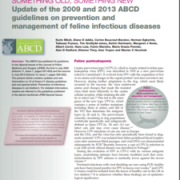Journal of Feline Medicine and Surgery (2015 issue)
(Link to the 2015 issue)
This issue contains update articles of the 2009 and 2013 guidelines, and new recommendations for cats with different lifestyles, rescue shelter cats and breeding catteries – which we have called “Matrix vaccination guidelines”.







